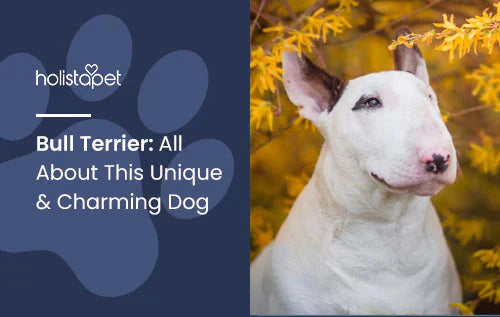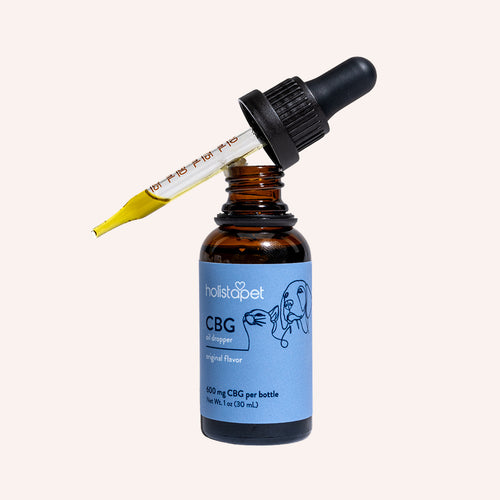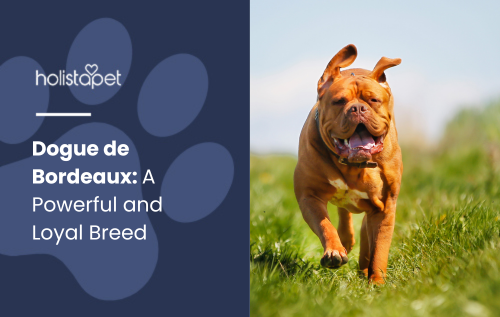There are few things that Target doesn't carry, and that includes the English Bull Terrier. Although you'll recognize this breed as the face of Target, we hope that you're responsible enough to purchase from a reputable breeder and not a retailer! Wait, I've been informed that they do sell this dog. Relax, it's a stuffed animal!
Breeders originally developed the Bull Terrier for dogfighting in the 19th Century and later as a fashionable companion for gentlemen. Today, they make great family dogs and even show dogs! Their unique appearance makes them easy to spot. Keep reading to learn more about Bullseye, the Target dog breed! I mean, the Bull Terrier breed!
Bull Terrier Characteristics
The Bull Terrier has unique characteristics that make it different from any other dog. These dogs are strong and stocky and come in two varieties: standard and miniature. The most defining feature of this breed is its head, which is egg-shaped and flat on top. This dog is fiercely loyal and, today is a lot gentler than its ancestors. Though they are now a mild version of their ancestors, they are still strong-willed and fearless. The Bull Terrier walks around in an agile and confident way, emphasizing its power, skill, and agility.

- Head: The Bull Terrier has an egg-shaped head. This distinct feature is what sets them apart from all breeds. It sits atop its long, sturdy neck with eyes set high up along the head. They are tiny, dark, close-set, and uniquely triangular. Ears are small, upright, and pointed upward.
- Body: This breed has a robust, muscular, and big-boned physique. People describe them as stocky, but you shouldn't underestimate the defined muscles this dog has all over its body. This dog has strong muscular shoulders.
- Limbs: The front and back legs are short with lean muscle. Its hindquarters feature a slight slope due to its front legs being slightly longer than its hind legs.
- Tail: Its tail is short and thick near the body and tapers off towards the end.
Breed Size
Though stocky, the Bull Terrier is a compact dog that holds a lot of muscle. Who would've thought such a small compact breed is that strong. On average, a male Bull Terrier puppy weighs 55 to 65 pounds and measures up to 22 inches in height. A female bull terrier can be slightly smaller but usually measure about 22 inches in height and can weigh up to 33 pounds.
A miniature Bull Terrier is just a Bull Terrier but smaller. Everything is automatically ten times cuter when it's miniature! These miniature versions stand between 10 to 14 inches at the shoulder. Unlike their standard counterparts, these dogs can weigh 20 to 35 pounds.
Related: How Heavy Should My Dog Be? 5 Ways To Tell If Your Dog is Overweight
Personality
While these dogs make great family pets, it's important to socialize your Bull Terrier puppy early on. This will help quell any social anxiety they may have and lessen any aggression they may exhibit in the future. Bull Terriers are not recommended for novice dog owners. They are very intelligent and headstrong and require certain levels of care and discipline. But don't worry, your consistency will be rewarded with a well-behaved dog!
Despite its strong and protective fighter history, the Bulldog Terrier is an affectionate charmer. This dog is friendly and has an affinity for both adults and children (really for anyone that will partake in its rambunctious, playful endeavors). Most may find its antics both comic and endearing. The Bull Terrier refuses to take the backseat to anything. They have a strong presence that reflects intelligence, sensitivity, devotion, and loyalty. This breed loves to be around people and is always ready for action or play.
Breed Exercise
Bull Terriers have a lot of energy and a quirky, goofy personality. This breed needs vigorous daily exercise! Your Bull Terrier must get anywhere from 30 minutes to an hour of play daily. Walking, running, and jogging are a few things that will allow your dog to get its daily dose of exercise. The Bull Terrier tends to become lazy and even overweight if not properly exercised.
Please take advantage of your dog's teeming energy to take them with you on your workouts or even teach them new tricks! Miniature Bull Terriers require less rigorous exercise but still have the tenacity and energy as their standard counterparts. Make sure that Bull Terrier puppies don't overexert themselves while running around outside. As much as this breed needs to exercise, it is equally important to stay well hydrated. Here are a few other activities that you can interest your Bull Terrier in:
Breed Training
Owners should be mindful that this breed exhibits the tenacity of the Bulldog but is also a member of the Terrier group. This makes them an independent free-thinker with a higher commitment to fun and games than to work ethic. I mean, who says we can't have fun all the time? Like most other dogs, Bull Terriers will operate on the principle that if it's fun, they will follow through.
If it's not, what's the point? The point is to have a well-behaved dog no matter the environment you may find yourself in. This is why it's important to make training fun and interactive. Positive reinforcement with treats or playtime is an excellent place to start. A Bull Terrier requires a firm owner but doesn't resort to physical force or harsh words. As mentioned previously, this breed isn't a fit for novice pet owners. They are not always the easiest to train due to their headstrong attitude.

Bull Terrier Breed History
Breeders probably created the Bull Terrier by crossing a Bulldog with the now-extinct English Terrier. These bull and terrier dogs were later crossed with Spanish Pointers to increase their size. This breed dates to approximately 1835. At the start of the 19th Century, people developed the "bull and terrier" breeds to help with the need for vermin control and animal-based blood sports.
People began breeding bulldogs with terriers claiming that the mixture enhanced the quality of fighting. Little was done to preserve the breed in its original form when the Bull Terrier was first bred. At this time, breeding was for performance and functionality, not appearance. James Hinks started breeding "bull and terriers" with English White Terriers. He was looking for a cleaner appearance with better legs and a nicer head.
Originally, these dogs did not have the now-familiar "egg face" but kept the stop in the skull profile. "Stop" is used to describe the degree of angle slope between the skull and the nasal bone near the eyes and the indentation between the eyes where the nose and skull meet. The dog was immediately popular and was bred with Dalmatians, Spanish pointers, American Staffordshire Terrier, and Whippets to increase agility. The first modern Bull Terrier (1917) is now recognized as "Lord Gladiator," the first dog with no stop.

Common Health Problems Found in the Bull Terrier
Most purebred dogs face their fair share of genetic issues. This can be caused by a lack of breeding standards which results in inbreeding. Although some of these health concerns can be avoided with safe breeding practices, others result from the dog's genetic makeup.
Deafness
People have recognized deafness in Bull Terriers since the inception of the breed. Recent studies have concluded that as many as 18% of white Bull Terriers in the US are hard of hearing. For years, people thought that deafness was mainly attributed to white Bull Terriers. However, colored Bull Terriers can also be affected, though at lesser rates. Deafness can occur in either or both ears.
Bull Terriers only deaf in one ear are sometimes referred to as "unilateral." Unilateral make perfectly good pets, and often, it is hard to even tell that the dog is partially deaf. A sign of a unilateral Bull Terrier puppy is that it runs in the wrong direction when called or "scans" the horizon when hearing a sound.
Deaf Bull Terriers are a different matter altogether and often find it difficult to adapt to normal life. They are extremely difficult to train and can take any sudden movements as a sign of threat. These dogs can also become defensive when woken suddenly because they cannot hear. Deaf Bull Terriers should never be bred from. A responsible and reputable breeder will not knowingly sell a deaf Bull Terrier.
Skin and Coat Disorders
One of the most common ailments seen in Bull Terriers is skin problems, which often appear to be allergy-related and seasonal. The symptoms can vary from small rashes and spots to manage and other conditions. In extreme cases, if dog skin care is ignored, these conditions can lead to complete loss of hair and the development of "Rhino" type, hard skin.
Though these conditions are not fatal, affected animals suffer extreme discomfort. Why Bull Terriers are susceptible to skin conditions is not necessarily known. It is believed that their immune system may not be strong enough to deal with problems that should be shrugged off quickly.
Kidney Disease
Just like deafness, kidney failure in Bull Terriers has been a recognized problem for many years. It can appear at any point in a dog's life and often result in an early and very distressing death for the animal. Once an animal has been diagnosed with kidney failure, there is little to be done as there is no cure. There are certain things your veterinarian may recommend to prolong their life and even make their remaining time with you more comfortable.
Heart Disease
Bull Terriers have been identified as being susceptible to varying degrees of heart disease. These diseases usually affect the heart valves, failing to close properly or even narrow the arteries. These animals can suffer from heart attacks, while other signs include inactivity and shortness of breath.
Some Bull Terriers may have a heart murmur their entire lives without any ill effects being present. It is unadvised to breed an animal with any sort of heart defect. Puppies may have a heart murmur in early life that will disappear as it gets older.
Patella Luxation
A dog's patella is equivalent to the knee joint in humans. The groove usually causes patella luxation in the knee joint not deep enough to hold the patella in place. This causes it to slip out to either side. This can be extremely painful for the dog. They can be seen to limp or "hop" on the affected leg. You can correct this condition through surgery, but it can be extremely expensive, normally only carried out by a specialist vet. Though there is a small chance that this condition can be fixed, animals may develop arthritis later in life.

How to Care For a Bull Terrier
Bull Terriers are unique in characteristics compared to other dogs. While their physical appearance makes them easy to spot, this breed requires the same care any other breed does. We all know this starts and ends with love! Who doesn't love a good dog?
Exercise
Certain dog breeds require mild exercise and may be content with a slow evening walk around the park. Others, like the Bull Terrier, require more vigorous exercise, especially those that were originally bred for hunting. Without adequate exercise, this breed can gain weight and vent its pent-up energy in negative ways. You know what we're talking about. Yes, we mean chewing, digging, and overall destruction. Bull Terriers are good for those who live active lifestyles or are interested in training their dog to compete in a dog sport.
Attention and Company
Some breeds bond very closely with their owners and don't do well with separation. Separation anxiety can cause destructiveness, barking, whining, chewing, and overall mayhem! Bull Terriers do best with a family member at home during the day, or if your work allows, take them with you!
Grooming and Upkeep
Bull Terriers are short flat-coated dogs that shed throughout the year. Grooming is suggested at 4 to 8-week intervals to clean ears, clip nails, and check anal glands. This will ensure that the coat and skin are in healthy conditions.
Nutrition and Feeding for a Bull Terrier
The right amount of food your Bull Terrier needs is dependent on their size and activity levels. You can determine this by discussing a proper diet with your vet, where they can assess your individual dog's needs. A healthy diet for the Bull Terrier provides it with a balance of proteins, fats, and carbohydrates.
Recommended serving for your Bull Terrier is 4 1/4 cups of high-quality dry food split up into two meals. Dogs are individuals and don't all require the same amount of food. This can become a trial and error process, and if you require more guidance, it is best to seek advice from a vet.
Coat Color and Grooming
The Bull Terrier comes in a variety of colors, and some even have markings! The American Kennel Club recognizes white as the breed standard, but these dogs can come in many colors. These are some of the colors the Bull Terrier comes in!
- Black and tan
- Brindle
- Red
- Red and white
- Black brindle
- Black, tan, and white

Children and Other Pets
Bull Terriers are gentle and affectionate with the entire family. This is especially true if they grew up around said family members. For a Bull Terrier to feel comfortable around children, it is important to socialize them with people of all ages. With socialization, you minimize the risk of having a nervous dog and canine depression.
This is also true of other pets. Your Bull Terrier will get along great with other animals as long as you have socialized them from an early age. It is harder to socialize a dog that has already internalized fear of certain environments or stressors. Having children around may even be ideal for the Bull Terrier!
They need lots of vigorous exercises, and who else do we know that loves running around in circles? Kids! Allowing one to entertain the other is a win-win situation. Though these dogs are relatively docile, it is always important to supervise children when they are around any animal.
Bull Terrier Dog Rescue Groups
Like many other dogs, Bull Terriers may end up in shelters when owners don't realize the level of care for a canine involved when adopting an animal. The main reason many of these dogs end up in shelters is their "aggressive" tendencies. Let's remember that many of these "tendencies" are born out of mistreatment and misunderstanding about this breed's needs. Luckily for us and all Bull Terriers, many organizations out there dedicate their lives to finding loving homes for these often misunderstood creatures.
Bull Terrier Rescue
This organization, like many others, dedicates its time to vetting and screening potential homes for the Bull Terriers they shelter. It is a group of individuals who want to give back to these animals and who consider themselves animal enthusiasts themselves. These volunteers are often the same ones who interview, review, and approve homes and provide hands-on care to these animals.
Bull Terrier Rescue Mission, Inc.
Based in New York, this group is committed to protecting the welfare and health of Bull Terriers. It extracts them from unfortunate circumstances and provides them with care and rehabilitation when needed. This organization addresses any dog's medical needs and gets the care they need. Once they are in shape and healthy, they put these dogs up for adoption, always making sure that the potential owner is fit to care for the animal.
Blue Ridge Bull Terrier Rescue
Located in Virginia, this group provides help throughout the eastern region. This rescue places unwanted, abused, or abandoned Bull Terriers in happy homes. Each rescue or surrender receives routine veterinary care, including spay and neuter services.

Bull Terrier Breed Organizations
If rescue groups weren't enough to exemplify the amount of Bull Terrier enthusiasts there are in the world, there are whole organizations that show off these beautiful, unique dogs!
The Bull Terrier Club
The purpose of the BTC is to represent all interests of Bull Terriers and their owners. They aim to provide information for owners or those interested in owning. This information ranges from simple companionship to those interested in the many competitive aspects of dog ownership. The BTC was first established in 1887 and prides itself on being one of the world's largest clubs of its type.
Bull Terrier Club of America
This organization is a parent club member of the American Kennel Club. This club describes itself as a club of "Bull Terriers" who get together to host shows, provide information, and support various events throughout the country. Many club members have certified therapy dogs that visit nursing homes and hospitals.
Final Thoughts
The Bull Terrier has a history that may give it a bad rap. Not to mention, their physical appearance is unique and doesn't necessarily give the breed a very approachable look. Much to your surprise, these dogs are naturally goofy and playful. They love their owner and love being by your side. So if you're looking for an actual life companion, this is the guy or gal for you!
Just like any other animal, Bull Terriers have their own set of needs aside from love, food, and shelter. These rambunctious dogs need tons of exercise, preferably in a wide fenced yard. But overall, what this Spuds Mackenzie breed really needs is lots of love!


 CBD Oil for Dogs - Fast Acting
CBD Oil for Dogs - Fast Acting
 Chicken Flavored CBD Oil For Dogs - Easy Dose
Chicken Flavored CBD Oil For Dogs - Easy Dose
 Salmon Flavored CBD Oil For Dogs - Highly Rated
Salmon Flavored CBD Oil For Dogs - Highly Rated
 CBG Oil for Dogs and Cats - Loved by Thousands
CBG Oil for Dogs and Cats - Loved by Thousands





Leave a comment
All comments are moderated before being published.
This site is protected by hCaptcha and the hCaptcha Privacy Policy and Terms of Service apply.